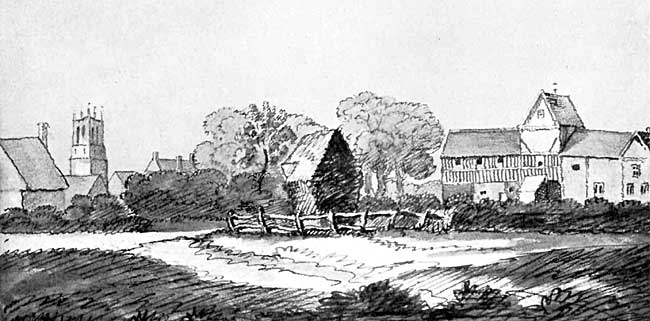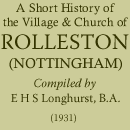Village history
ROLLESTON, in the County of Nottingham, is a village of about 230 inhabitants and lies in the valley of the River Trent some 5 miles from Newark and 2½ miles from Southwell, on the L.M.S. Railway between Lincoln and Nottingham.
The early history of Rolleston is of considerable interest. The Domesday Book, compiled in 1086, shows that at the time of the Norman Conquest there were three Manors in Rolleston. After the Conquest in 1066, the first manor, which had been in the possession or tenancy of Aluric, was transferred to the fee (or estate) of Thomas, Archbishop of York. The second and best was formerly held by Godwin, who was deposed to make room for Odo, Bishop of Bayeux, half-brother to William I. The Bishop's tenant was Lefoardus and there were three mills in this manor. The third manor formerly belonged to Tori, but this was then transferred to the fee of Walter d'Aincourt. From the Domesday Book we also gather that there was "a priest and a church,'' and that the latter was in Walter d'Aincourt's manor.
Tracing the history of the manor of Odo, Bishop of Bayeux, we find that apparently this was later transferred to the Earl of Richmond, who granted the tenure to the family of Rollestons, knights, for early in the 13th century Amflicia de Rodliston (or Rolleston) married Jolan de Neville, bringing him the Manor of Rolleston as dowry. The following is dated 1375:—
"The King to the archbishops, etc............................ greeting.
Know ye that we have granted & by this our charter confirmed to Jollan de Nevill that he & his heirs for ever have free warren in........................ Roldeston in the County of Nottingham.................. So that no one may enter those lands for the purpose of hunting in them or for taking anything which appertains to the warren without permission...................... from the said Jollan or his heirs on pain of forfeiture of 10 pounds. Whereof we will, etc..................... "
The Nevilles held this manor until the time of Queen Elizabeth, when it was sold to Nicholas Lodge, an Alderman of London (a Tablet to whom is situated over the door in the chancel of Rolleston Church) from whom "by mean conveyance" it became the inheritance of the Suttons, Lords Lexington, in whose estate the greater part of Rolleston remained until after the Great War, when it was purchased in 1919 by the Ministry of Agriculture for the purpose of founding a farm settlement for Ex-Service Men.
The moated enclosure whereon the ancient Manor House formerly stood came, however, into the possession by purchase of Thomas Searcy Cullen, whose family for several generations had held the tenancy of the farm which included the ancient site.
Shilton's "History of Southwell" (1818) states "... The Manor House, a remarkably antique structure, moated round, was taken down in 1813, and several silver coins of Henry VIII found, all or most of them in the vile debased state mentioned by historians.................. " That there was at one time a chapel in the Manor House itself is evident from a licence dated 1456, to John, Prior of Lenton, to marry "in the chapel within the manor house of Thomas Neville at Rolleston."

"View in ye Village of Rolleston, near Newarke." Possibly the ancient Manor House of the Nevills, demolished in 1813. Reproduced from the original water-colour sketch by J. Digby Curtis, about 1800, by kind permission of Mr. G. A. Matterson.
The site of the Manor House is still well defined, with its moats, fishponds, etc., the supply of water to which was from the River Greet until the railway was built. In front of the site stands the stump of an old stone cross, the original purpose of which may have been that of a boundary cross. Two 15th century stones, carved with the Nevill arms, are now used to carry the hinges of a barn door near the site, whilst two more stones stand in the garden of the present Manor Farm House. Other carved stones were found during the demolition of some cottages in more recent years which may have formed part of a parapet of either the old Manor House itself, or of the Nevill Chapel at the Church before it was demolished.
In the centre of the village stands the base of another old cross, round which there were at one time several carved shields, but these can no longer be seen; this cross would seem to show that there was formerly a Market at Rolleston (Shilton—" History of Southwell"). Within living memory the portion of ground adjacent to this cross, now cultivated, and surrounded on three sides by the road, used to form the Village Green, where also the ancient Stocks (now disappeared) for the punishment of evil-doers were placed ; the actual use of these is still remembered by an old resident, who confesses to ridiculing, as a little girl, an offender undergoing the punishment.
Another feature of olden days which has disappeared is the Pinfold, an enclosure erected by local authority wherein stray or trespassing cattle or other beasts were confined. This was situated at the east end of the village on the road towards Fiskerton. Items concerning the Pinder's salary, and for repairs to both pinfold and stocks, appear in the old account books of the various Parish Constables and Overseers of Rolleston. An entry in the Church Register gives the burial on September 7th, 1590, of one "Thomas More..................... the townes pinder and swinheard beeinge stricken with lamenes in his last dayes....................... "
In the Marriage Registers we find an entry of the marriage of John Miller, of St. James, Westminster, and Ann Smith, of Rolleston, on the 28th July, 1831. There is interest attaching to this, since John Miller was Chef to King George IV., William IV., and Queen Victoria, and possibly also to George III. When he resigned he wished to live at Rolleston, his wife's native home; being unable to obtain a suitable house he built one for himself on what was then "waste" ground adjoining the moated homestead, and there he lived until his death in 1873. He was a great Churchman, and his name appears in the list of Churchwardens from 1842 to 1859; he also took his place in the Orchestra which at that time led the singing in the Church, and taught in the Sunday School, even if he did not superintend it. When he died his house would revert to the Lord of the Manor.
Another interesting personality who used to visit Rolleston was Kate Greenaway, the English artist and book illustrator, especially well-known for her children's books and illustrations, and her designs for children's costumes. When visiting the village she stayed at the cottage of Thomas Chappell, whose portrait she used to paint, as well as picturesque portions of the cottage and its surroundings, and parts of the old kitchen.
Several picturesque old cottages with their thatched roofs have been pulled down since the beginning of the present century, and modern ones erected since the Great War under the before-mentioned scheme of the Ministry of Agriculture. Early this year (1931) an Electric Light and Power Supply was made available to the village.
Adjoining the Railway Station is the Course of the Southwell Hunt Race Club; previous to 1898 these Races were held at Southwell.
